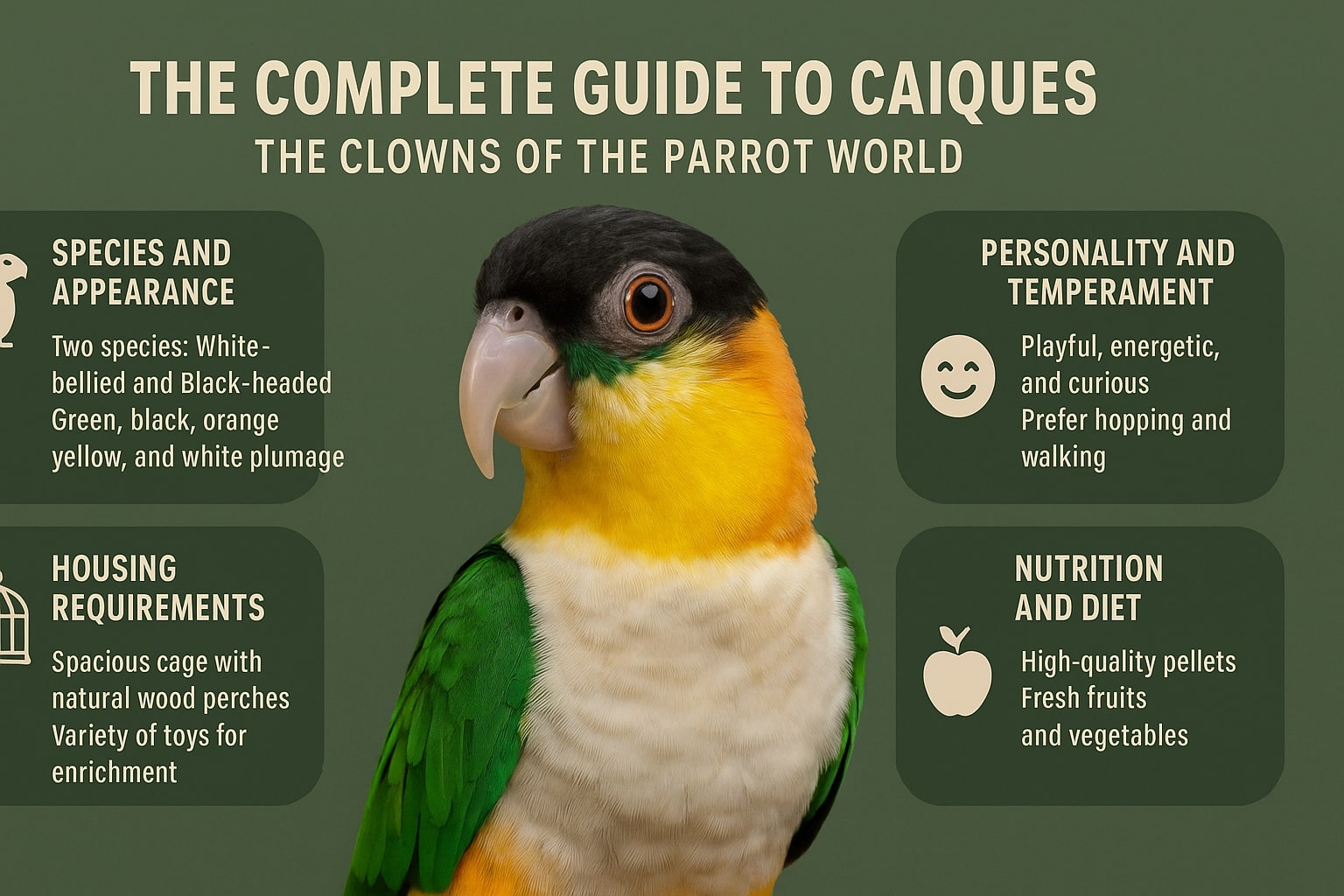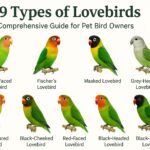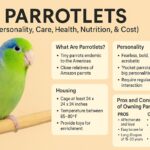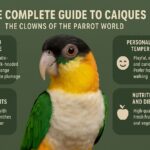If you are looking for a feathered companion that will keep you entertained for hours with their playful antics and vibrant personality, the caique might be the perfect bird for you. These small, colorful parrots have earned their reputation as the “clowns of the parrot world” through their high-energy behavior and comical nature.
For pet bird owners considering adding a caique to their family, understanding these remarkable birds is essential for providing proper care and building a strong bond.
What Makes Caiques Special
Caiques, pronounced “kai-eek,” are medium-sized parrots belonging to the genus Pionites3. These South American natives are instantly recognizable by their distinctive appearance and energetic personalities. Unlike many other parrot species, caiques have earned their place in the hearts of bird enthusiasts not just for their beauty but for their incredible ability to entertain and engage with their human companions.
The name “caique” itself comes from the term for a Turkish vessel, likely referring to their bright colors and compact, sturdy build. These birds have historically been called the “seven-colored parrot” due to their vibrant plumage that combines green, black, orange, yellow, white, and blue features.
Species and Physical Characteristics
There are primarily two species of caiques commonly kept as pets: the White-bellied Caique (Pionites leucogaster) and the Black-headed Caique (Pionites melanocephalus). Both species are endemic to the Amazon Basin region in South America.
White-bellied Caique
The White-bellied Caique is slightly larger and heavier than the two species, measuring approximately 23 cm (9 inches) in length and weighing between 161-170 grams. These birds are characterized by their apricot-colored crown, nape, and upper ear coverts, with yellow coloring on the lores, throat, and sides of the head.
Their most distinctive feature is their creamy white breast and abdomen, which gives them their name. The upperparts are green with blue-margined secondary feathers, while their thighs are green, and the undertail coverts are yellow.
Black-headed Caique
The Black-headed Caique is distinguished primarily by its black crown, which is the main difference from its white-bellied cousin. These birds measure about 23 cm (9 inches) in length with a wingspan of 36 cm (14 inches) and weigh approximately 160 grams.
Like their white-bellied relatives, they have the characteristic white “belly” area, but their black head coloring makes them easily distinguishable.
Both species have strong, pink-colored beaks and pink legs and toes. Their eyes are particularly striking, with adults having orange to red irises, while juveniles start with brown eyes that gradually change color as they mature.
Personality and Temperament
Caiques are renowned for their playful, energetic, and sometimes mischievous personalities. These birds are extremely active and curious, spending their time exploring, playing, and engaging with their environment. Their high energy levels and acrobatic abilities often lead to entertaining displays that can include turning over and laying on their backs while playing.
One of the most endearing characteristics of caiques is their preference for hopping and walking rather than flying. This unique locomotion style, combined with their confident, swaggering walk, adds to their charm and makes them particularly amusing to watch. They are expert climbers with very strong feet and legs, making them excellent at navigating various perches, toys, and play structures.
However, caiques can also display challenging behaviors. They are known to be territorial and stubborn at times, and may resort to biting or screaming when they don’t get their way. These intelligent birds can be quite competitive, and what starts as playful activity can quickly escalate into extreme excitement. Early socialization and consistent training are crucial for managing these tendencies.
Social Needs and Bonding
Caiques are highly social creatures that crave attention and interaction. In the wild, they live in flocks ranging from 25-30 members and are rarely seen alone. This social nature translates directly to their needs as pets, where they require significant daily interaction with their human family.
These birds typically choose a favorite human family member, although they should be socialized with as many people as possible from a young age to prevent behavioral issues. When properly socialized and given adequate attention, caiques can be incredibly affectionate companions, often seeking out cuddles and physical contact with their owners.
Pet caiques need at least two hours of direct attention each day. Without sufficient interaction, they can become aggressive, nippy, or develop destructive behaviors. Their need for social interaction is so strong that neglected caiques may resort to loud screaming to get attention.
Housing Requirements
Providing appropriate housing for a caique is crucial for their physical and mental well-being. These active birds require spacious cages that accommodate their high energy levels and need for movement.
The minimum recommended cage size for a single caique is 24″ x 24″ floor space, though larger cages of 24″ x 30″ or even 36″ wide are preferred. The cage should have bar spacing of 3/4″ to 7/8″, with a maximum of 1″. Caiques will use every inch of available cage space, so bigger is always better.
The cage should be equipped with natural wood perches of varying thickness to exercise their feet and keep them healthy. One cement or nail conditioning perch can be included to help keep nails trimmed, but feet should be examined regularly for signs of irritation. A variety of toys is essential, as caiques require mental stimulation to prevent boredom.
These birds are known as heavy chewers and require a steel cage with different sized perches to accommodate their natural behaviors. The cage should be placed high above eye level to help the birds feel safe and secure.
Nutrition and Diet
Proper nutrition is fundamental to maintaining a caique’s health and supporting their active lifestyle. A well-balanced diet for caiques should consist of approximately 60-80% high-quality pellets, with the remainder being a mixture of fresh fruits, vegetables, nuts, seeds, and treats.
Pelleted Food
High-quality pelleted diets should form the foundation of a caique’s nutrition, as they are specifically formulated to meet the nutritional needs of parrots. Recommended brands include Tropican Parrot Sticks, which many caiques prefer due to the larger size that allows them to hold the food in their feet while eating.
Fresh Foods
Daily offerings of fresh vegetables are essential and should include leafy greens, carrots, bell peppers, broccoli, sweet potatoes, green beans, corn, and spinach. Fruits such as apples, berries, mangoes, pears, and bananas can be offered in moderation as treats.
Since caiques eat insects in the wild, small portions of cooked egg, chicken, beans, or other healthy proteins should be provided regularly. This protein supplementation is important for their overall health and energy needs.
Foods to Avoid
Several foods are toxic to caiques and must be strictly avoided, including chocolate, avocado, onion, garlic, caffeine, alcohol, and high-fat, high-sodium, or high-sugar foods. Additionally, foods containing artificial sweeteners should never be given to these birds.
Peanuts, while not necessarily harmful, are generally not recommended due to the risk of fungal contamination. If peanuts must be given, only those intended for human consumption should be used.
Fresh water should be available at all times and changed daily. All fresh foods should be removed within 24 hours to prevent spoilage.
Health Considerations
Caiques are generally hardy birds, but like all parrots, they require regular veterinary care to maintain optimal health. All birds should receive annual veterinary examinations, with newly acquired birds being examined within the first few days after purchase or adoption.
Common Health Issues
While caiques are relatively healthy birds, they can be susceptible to certain conditions. Congenital glaucoma has been documented in white-bellied caiques, though this is considered rare. Obesity is a more common concern, particularly in birds fed seed-only diets, which is why pelleted diets are strongly recommended.
Preventive Care
Regular nail and wing trims should be performed by an avian veterinarian. Because caiques are heavy-bodied birds, their wings must be trimmed conservatively to prevent injury from falling.
Signs of a healthy caique include being perky, active, and alert with bright, clear eyes and nostrils. Healthy birds should eat and drink regularly throughout the day and appear well-groomed with neat, bright feather. Any changes in behavior, appetite, or appearance should prompt immediate veterinary attention.
Enrichment and Mental Stimulation
Caiques are intelligent birds that require significant mental stimulation to prevent boredom and behavioral problems. These clever creatures need a variety of toys and activities to keep their minds engaged.
Toy Recommendations
Foraging toys are particularly important for caiques as they satisfy their natural instinct to search for food. Puzzle feeders, treat balls, and foraging boxes that can be filled with favorite foods or treats provide hours of entertainment.
Wood and rope toys give caiques the chewing opportunities they need to keep their beaks healthy and trim. Cardboard and paper toys are excellent for shredding, which caiques find particularly satisfying. Willow, palm, coconut, and cactus toys provide additional textures for exploration and manipulation.
Acrylic and metal toys are durable options that can withstand the intense play sessions that caiques enjoy. These toys can often be filled with small treats to make them even more engaging.
Rotation and Variety
Toys should be rotated regularly to maintain the bird’s interest and prevent boredom. Having a variety of different types of toys available ensures that caiques have options based on their mood and energy level24.
Training and Behavior Management
Training is essential for caiques to become well-behaved family members. These intelligent birds respond well to positive reinforcement techniques, but their strong-willed nature means that consistency and patience are required.
Early training and socialization are crucial for preventing behavioral problems. Caiques should be handled regularly in quiet, relaxed situations, but care should be taken not to overstress the bird during the initial adjustment period.
These birds can be taught various tricks and commands, and their high intelligence makes them capable learners. However, their competitive nature means that training sessions should be kept positive and engaging to prevent them from becoming overly excited or frustrated.
Noise Levels and Apartment Living
While caiques are not the loudest parrots, they can be quite vocal, especially when seeking attention. They are generally louder than green-cheeked conures but quieter than quaker parrots. Their calls can be described as high-pitched and can include whistles, chirrups, and shrieks.
Most caiques have specific times when they are more vocal, such as morning and evening periods. With proper training and attention, many caiques can learn to have designated “loud times” and be relatively quiet during other parts of the day.
For apartment living, caiques may be manageable if their social and exercise needs are met, but potential owners should consider their neighbors and local noise restrictions.
Talking Ability
While caiques have the anatomical capability to mimic human speech like other parrots, they are not known as prolific talkers. Some caiques can learn words and phrases, but they are more likely to imitate repetitive sounds like phones or microwaves rather than develop extensive vocabularies.
Individual birds vary significantly in their talking ability, and there are reports of caiques that have learned to speak well. However, potential owners should not choose a caique primarily for talking ability, as many individuals may never develop significant speech skills.
Lifespan and Long-term Commitment
Caiques are long-lived birds that represent a significant long-term commitment. In captivity, they typically live 25-30 years, with some individuals reaching up to 40 years with proper care. This longevity means that prospective owners must be prepared for potentially decades of care.
Female caiques often tend to live longer than males, and proper diet, exercise, and veterinary care can significantly impact lifespan. The extended lifespan of caiques makes them unsuitable for first-time bird owners who may not fully understand the commitment involved.
Cost Considerations
Caiques are relatively expensive birds, with prices typically ranging from $700-$2,000 for a single bird. Current pricing from reputable breeders shows both White-bellied and Black-headed Caiques selling for around $1,700 each, including DNA sexing. Female birds often cost more than males due to their breeding potential.
Beyond the initial purchase price, ongoing costs include high-quality food, toys, veterinary care, and potential cage upgrades. The long lifespan of caiques means these costs will accumulate over many years.
Conclusion
Caiques offer a unique and rewarding pet ownership experience for those prepared to meet their high energy and social needs. These “clowns of the parrot world” bring joy, laughter, and companionship to their families through their playful antics and affectionate nature. However, they require dedicated owners who can provide consistent attention, proper nutrition, adequate housing, and ongoing veterinary care.
Before bringing a caique home, potential owners should carefully consider their ability to provide 20-40 years of care, their tolerance for noise and messiness, and their commitment to daily interaction and training. With proper preparation and dedication, caiques can make wonderful lifelong companions that will enrich their owners’ lives with their vibrant personalities and entertaining behaviors.
For those ready to embrace the joy and challenges of caique ownership, these remarkable birds offer an unparalleled companion animal experience that few other species can match. Their intelligence, playfulness, and capacity for forming strong bonds make them truly special members of the parrot family.
- Parrotlets (Personality, Care, Health, Nutrition, & Cost) - June 20, 2025
- Caique (Personality, Care, Health, & Nutrition) - June 20, 2025
- The Complete Guide to Golden Retrievers - June 9, 2025















